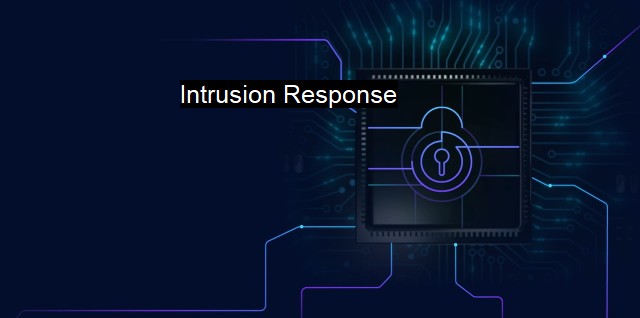What is Intrusion Response?
Mitigating the Damage: Understanding Intrusion Response for Cybersecurity Threats & Attacks
Intrusion Response in the context of cybersecurity refers to a set of predefined procedural steps taken immediately after a cybersecurity breach or intrusion has been identified. The intention is to control and minimize damage, enhance recovery, and prevent future similar incidents.Cybersecurity has become exponentially crucial in the recent technological era. With the increasing reliance on computer systems, networks, and digital platforms for everyday operations, threats have surged simultaneously. If a system's security is compromised or an intrusion takes place, it could lead to a catastrophic loss of data, damage to the system, financial losses, and even harm to a business's or individual's reputation. Hence, an effective intrusion response plan is vital.
Intrusion response typically focuses on advanced methods to identify, mitigate, and prevent cyber threats. An intrusion can come in many forms; it could be an unauthorized access to a network by a hacker, a malware-infected computer within the network spreading the malware, or even an insider threat within an organization. Whatever the situation is, a proactive and efficient approach towards dealing with such intrusions can significantly cut the impact on both the organization and its clients significantly.
The core components of an Intrusion Response plan are detection, assessment, mitigation, reporting, and review. Detection includes regular monitoring of the system to promptly identify any anomalous or suspicious behavior that might signify a cyber threat. Assessment involves an in-depth analysis of the detected threat or vulnerability to understand the impact, scope, and potential aftermath.
Upon understanding the severity of the incident, mitigation steps are planned out and executed. This typically involves isolating the impacted systems, ejecting the intruder, removing the malware or patching the vulnerability, and restoring the systems to their normal status.
Reporting is an indispensable part of an intrusion response plan. All the details about an incident including the severity, impact, response, and aftermath should be adequately documented. This documentation serves as a formal record of the incident which can be beneficial for both internal and audit purposes. it might also be legally required depending on the jurisdiction or the nature of the information compromised.
The final element, review, involves a thorough retrospection of the incident and how it was handled. This allows for the identification of any areas of possible improvement or amendments in the policies, practices, or systems in a bid to strengthen the security posture against future threats.
Intrusion response is also deeply affected by the use of antiviruses. Antivirus software, in general, forms the first line of defense against most forms of intrusion attempts. They offer comprehensive and automatic protection against various types of malware such as viruses, trojans, worms, spyware, and ransomware. By doing so, they help to keep intrusions at bay most of the time. because cyber threats continuously evolve, antiviruses alone can't always guarantee complete protection.
Generally, the intrusion response in cybersecurity refers to recognizing a cybersecurity threat and effectively managing it in order to prevent future attacks that might challenge the system. It is closely linked with antivirus protection, where antiviruses merely form the first line of defense while an intrusion response provides more comprehensive systematic protection. The inevitability of cyber threats in the modern digital age signals the indispensability of efficient intrusion response planning in every organization. Every cybersecurity plan should involve an effective intrusion response component to rapidly mitigate potential damage, facilitate recovery, and prevent future security breaches.

Intrusion Response FAQs
What is intrusion response?
Intrusion response is the process of identifying and responding to potential security breaches or attacks on a system. It involves detecting, analyzing, and mitigating the impact of an intrusion in order to prevent further damage or loss of data.What are some common types of intrusion response?
Some common types of intrusion response include incident response planning, threat intelligence analysis, security information and event management (SIEM), and network forensics analysis. These techniques help identify and respond to potential security breaches or attacks in real-time, ensuring that data remains safe and secure.Why is intrusion response important for cybersecurity?
Intrusion response is critical for maintaining the security and integrity of a system. Without effective intrusion response measures, systems are vulnerable to cyber attacks, which can lead to data breaches, financial loss, and reputational damage. Intrusion response helps to mitigate the impact of potential attacks, minimizing the risk of a breach and ensuring that data remains secure.What skills are necessary for effective intrusion response?
Effective intrusion response requires a combination of technical skills, analytical skills, and communication skills. Technical skills include knowledge of cybersecurity tools and technologies, such as firewalls, intrusion detection systems, and antivirus software. Analytical skills are necessary for identifying potential threats and vulnerabilities, while communication skills are critical for coordinating responses across teams and communicating with stakeholders.| | A | | | B | | | C | | | D | | | E | | | F | | | G | | | H | | | I | | | J | | | K | | | L | | | M | |
| | N | | | O | | | P | | | Q | | | R | | | S | | | T | | | U | | | V | | | W | | | X | | | Y | | | Z | |
| | 1 | | | 2 | | | 3 | | | 4 | | | 7 | | | 8 | | |||||||